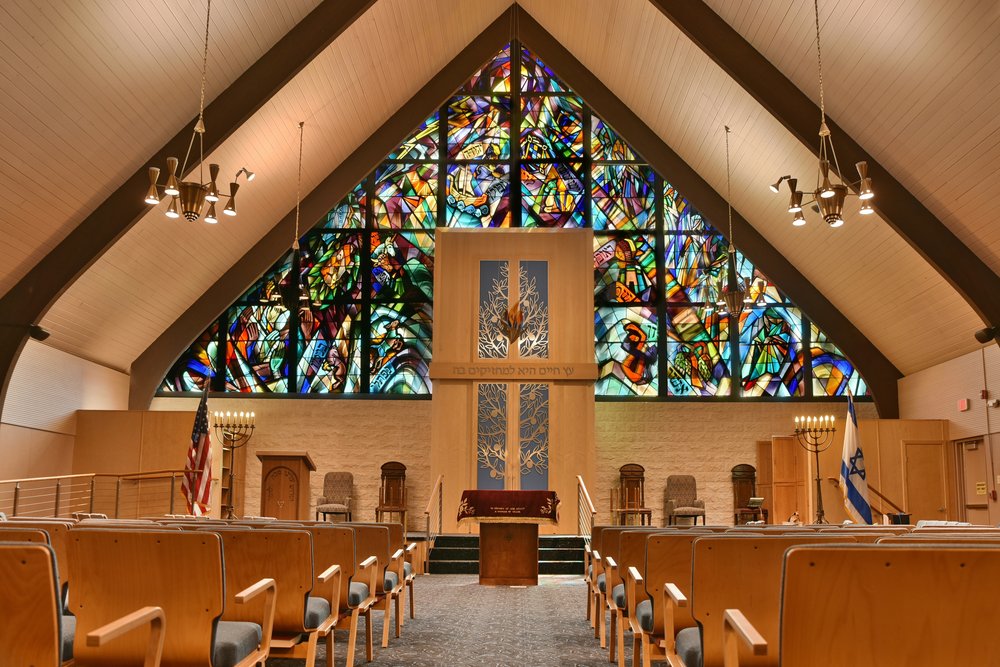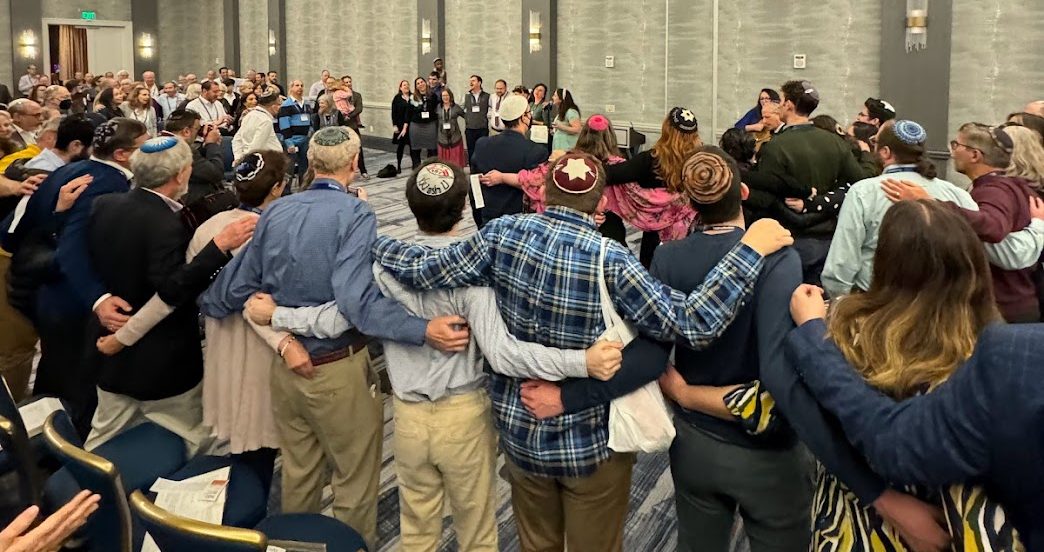The High Holidays are a time of commotion and planning, family and food and fasting, digging out the machzors and choosing the right outfit. Arriving at a High Holiday service should feel like coming home, whether you attend weekly services or come once a year, and whether this is the place you grew up or somewhere new. As synagogues and others prepare to host attendees in an environment dedicated to spiritual and emotional vulnerability, concerns of safety in the face of anti-Semitism are everpresent. For so many congregations, services might be held in a different location than their own regular building, and the influx of folks who attend once a year means many new and unfamiliar faces.
How do we think about preparing for High Holiday safety while making sure to cultivate a welcoming atmosphere for all of our attendees–both those who fit an expected mold of appearance and behavior, and those who don’t? And, if our High Holidays security approach includes outside help from contracted professionals or law enforcement, or in-house greeters who are better prepared for those they see weekly, how can we plan to get everyone on the same page with how to maintain safety in service of an environment of vulnerability for all? Jews of Color, people with invisible and visible disabilities, LGBTQ individuals and families, and interfaith families are some of the variety that comes to the entryways of High Holiday services, and without proper preparation, it is very easy to undermine the physical and emotional safety of these groups and more when our security plan targets pieces of their identities as things that don’t belong, or safety risks. For synagogue professionals, the High Holidays are a time to recruit members and present enticing appeals; it’s important to have a safety plan that doesn’t drive folks away.
On the Secure Community Network’s September 1 webinar entitled Creating Security & A Feeling of Safety for All, I shared a story of my sister’s first time attending Rosh HaShanah services outside of our home area. A Hebrew School graduate–faithfully attending from Kindergarten through Hebrew High!–and active member of Junior Choir, she was excited to attend with her secular Jewish boyfriend. He mostly remained seated, and was fairly checked out, while she was standing, sitting, and singing along with everyone else who was engaged, but when the Gabbai came around, they asked him if he wanted an aliyah and her how she knew the songs so well. “This is why I don’t do Jewish things anymore,” she says, and I’ve heard the same words from too many others after too many similar stories, and worse. Stories of folks quietly threatened with guns, stories of people detained or even physically dragged out of services not for causing a disturbance, but because someone with authority deemed them a security risk from appearance rather than behavior.
We can avoid those experiences this year. Last year’s comprehensive presentation during SCN’s High Holiday webinar series, Diversity, Equity, Accessibility, & Inclusion High Holidays Webinar, provides pointed tips and stories in addition to the recording from this year. I highly recommend reviewing all of the SCN High Holiday Security resources here. Among those tips, I’d like to highlight a few pointers.
- Have robust and thorough plans and expectations, and communicate them clearly and widely.
- The better prepared you are, the less you rely on discomfort with the unfamiliar as an indicator of safety risk.
- All staff and volunteers, including temporary clergy, should know who to share a safety concern with and how it will be handled. Make sure these team members are all familiar with one another by name and face and have knowledge of how to locate each other if needed.
- Plan and communicate multiple evacuation routes with clearly delegated responsibilities for aspects like initiating evacuation, delegating the crowd, and assisting those who need assistance.
- A clear and equitably applied policy on weapons–including guns, knives, and pepper spray–should be drafted and communicated to all, including attendees, and possibly posted at the entryway as appropriate.
- Training staff and volunteers on implicit bias, The Power of Hello, and de-escalation tactics helps increase effective surveillance and security.
- Discuss your community’s diversity, and your plan’s approach to being both welcoming and accommodating, with all partners, including local law enforcement.
- Request involvement from active and engaged members of your community who are also members of these communities in the planning process and, if appropriate and desired by them, in the implementation process. Ensure them that their involvement is not the only resource you are using to accommodate their safety needs, so that they can say no if they need to.
- Communicating safety protocols and expectations to attendees ahead of time and at appropriate times during the days is helpful. An email beforehand with what type of security measures will be in place (e.g. ushers, law enforcement, uniformed security officers, bag checks and metal detectors if any, what’s restricted, dress code if any), and expectations for congregants (e.g. frequency of entry and exiting, naming spaces that are designated for taking a break rather than the hallway, naming spaces that are off limits, equitable and inclusive expectations for children’s presence and behavior). The expectations should be reiterated verbally at the beginning, during announcements, and during shifts in the service as appropriate.
- Don’t assume that people are on the same page about your diversity and inclusion expectations, including any staff, contractors, and volunteers that may share identity factors with diverse attendees.
- Have an empathetic approach.
- An empathetic approach includes self awareness of the power and authority difference between you as a security team member and a service attendee, as well as recognizing the trauma triggers inherent in approaching someone who may expect to be viewed as different. When I’m coming to services, I have the same security concerns as everyone else about being a part of a large gathering of Jews. I, too, feel the heightened emotions of that risk.
- The presence of law enforcement, or uniformed security, is appreciated in that I know my fellow congregants may be safer, but it does not inspire feelings of heightened individual personal safety for me or much of my family.
- I am not one of those security concerns, and being approached as though I am only adds to my already heightened emotional state. Being asked if I’m new here by someone who’s a stranger and hasn’t even introduced themselves or their role makes me feel like they think they unconditionally belong and I do not.
- Introduce yourself and your role before asking anything of the person you’re approaching.
- Next, explicitly state the reason you’re approaching them. “I noticed I haven’t seen you here before, are you new?” is appropriate during small talk opportunities, but is a microaggression when assessing safety risks; we know why you’re there and we begin assessing our own safety in continuing to exist in this space. “I noticed you’ve been getting up and walking out a lot, and I needed to check if everything is okay,” means no one is pretending nothing’s wrong when something is.
- Empathy includes leaving room for alternate explanations for behaviors that may seem suspicious; not meeting eye contact may be a result of Autism Spectrum Disorder, social anxiety, or a cultural deference; sitting in the car idling for an extra 10 minutes before coming up to the entry may be doing some deep breathing before facing likely extra scrutiny; excessive fidgeting or entry and exiting might be ADHD or simple emotional overwhelm.
- Empathy includes awareness of intersectionality; a Jewish Latina woman may also have an Autistic son; a tall Black Jewish man might also be hard of hearing and not hear you call to him or be unexpectedly reactive to your shoulder tap; a non-Jewish spouse who uses mobility equipment may have social anxiety and already be uncomfortable about the space they’re occupying. Immutable social identities are not mutually exclusive, and are also not automatically intertwined and relatable to one another.
- An empathetic approach includes self awareness of the power and authority difference between you as a security team member and a service attendee, as well as recognizing the trauma triggers inherent in approaching someone who may expect to be viewed as different. When I’m coming to services, I have the same security concerns as everyone else about being a part of a large gathering of Jews. I, too, feel the heightened emotions of that risk.
As Racial Justice Specialist for USCJ, I offer resources, trainings, and answers to questions to affiliated synagogues; for further resources or to ask specific questions, please email me at [email protected]. As well, I offer support, solidarity, and affinity space for Jews of Color and their families. In mid-September, in partnership with URJ, we will be offering a drop-in 90 minute Zoom session for those impacted by racial marginalization in Jewish spaces (in particular, Jews of Color, non-Jewish People of Color in interfaith families, and non-POC parents of Jews of Color) in advance of the High Holidays. If you are interested in being notified of the session, or know someone who might be, please have them fill out this form. I look forward to continuing to work with our synagogues to create safe spaces for all participants.









